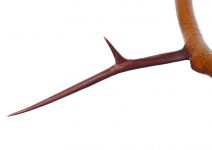Distribution: Occurring east of the Cascades crest and in the Columbia River Gorge in Washington; Washington to California, east across North America where native to the central and eastern regions.
Habitat: On edge of riparian zones, typically in areas with some level of disturbance.
Flowers: April-June
Origin: Introduced from central and eastern North America
Growth Duration: Perennial
Conservation Status: Not of concern
Large tree to 45 m., the trunk and branches armed with simple or branched spines 6-10 cm. long.
Leaves alternate, pinnate or bipinnate; pinnate leaves 10-15 cm. long, leaflets 15-37, elliptic, 2-4 cm. long, remotely serrate; bipinnate leaves up to 20 cm. long with 8-14 pinnae, each with up to 31 leaflets about 2 cm. long.
Inflorescence of pendulous racemes 5-15 cm. long; flowers inconspicuous, greenish, regular, not two-lipped.
Pods leathery, flat and twisted, 30-50 cm. long and 4-7 cm. wide, the numerous seeds embedded in pulp.
Publication: Sp. Pl. 2: 1056-1057. 1753.
PNW Herbaria: Specimen records of Gleditsia triacanthos in the Consortium of Pacific Northwest Herbaria database
WA Flora Checklist: Gleditsia triacanthos checklist entry
OregonFlora: Gleditsia triacanthos information
E-Flora BC: Gleditsia triacanthos atlas page
CalPhotos: Gleditsia triacanthos photos
























